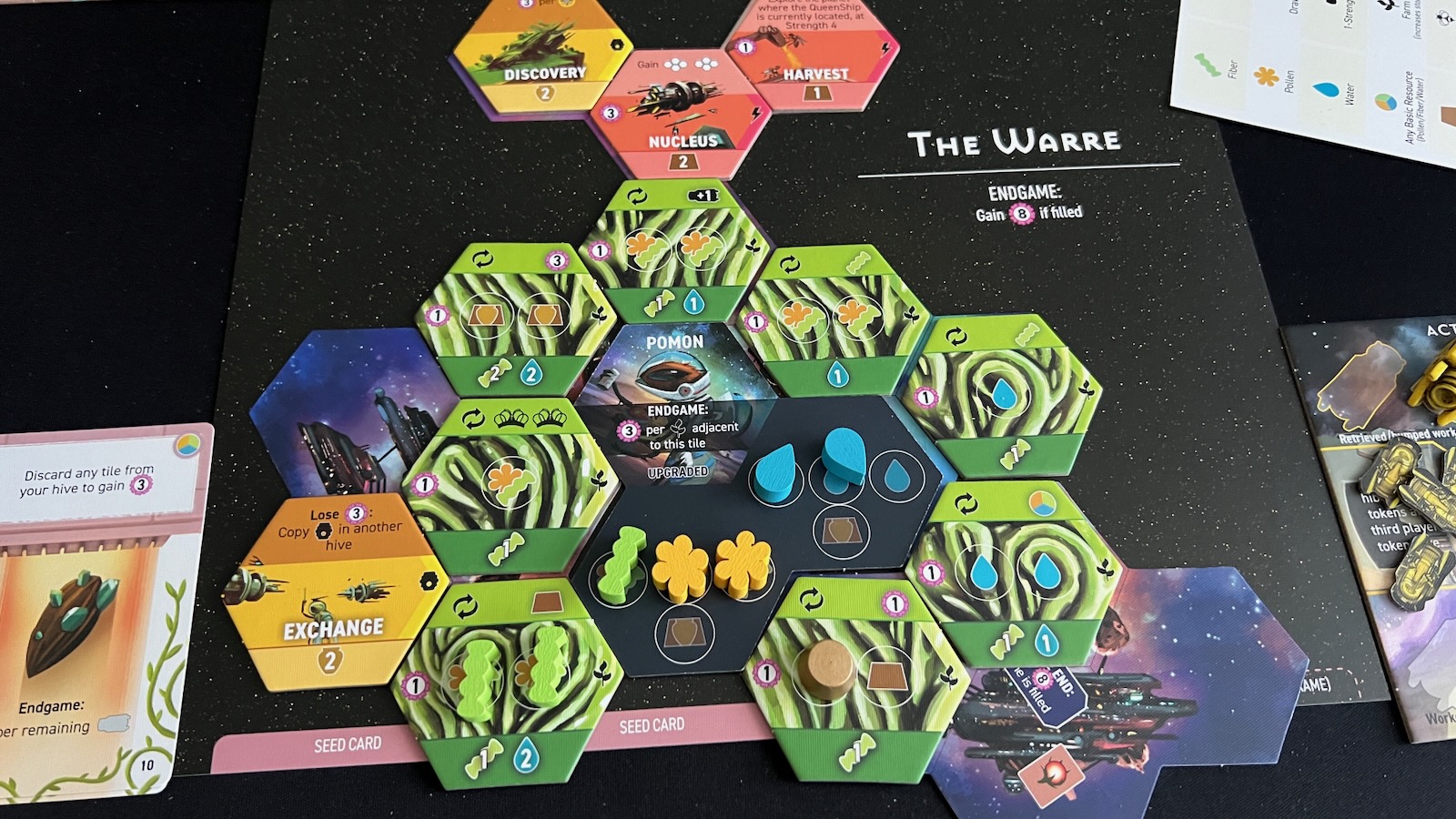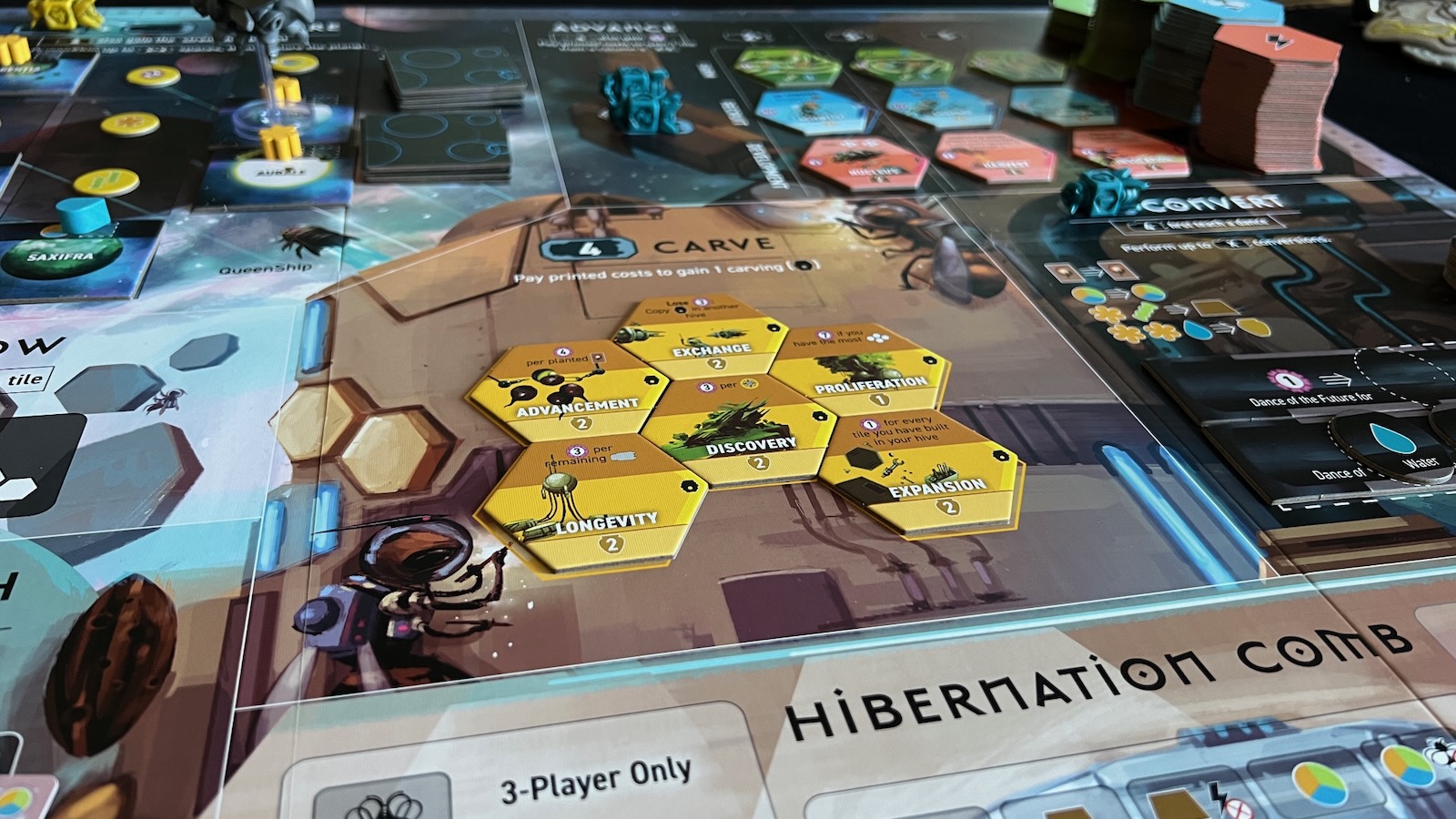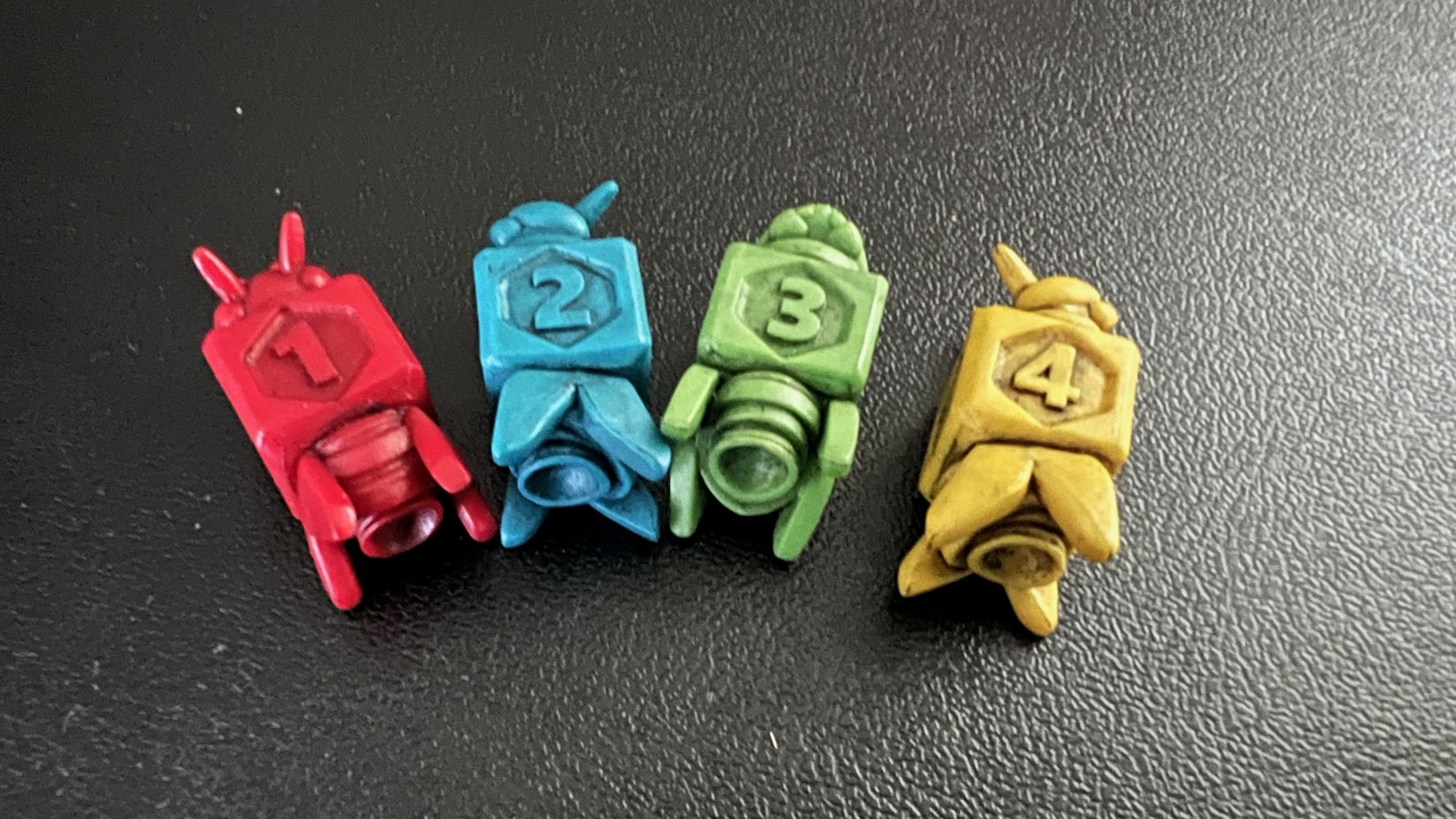There is something fascinating about bees. I have watched a ton of videos about hive relocations where all one has to do is find the queen, place them in a new hive, and the bees will follow. The way they work their entire lives for the good of the hive only to die off and be replaced by a new one. When I heard about Apiary, I was intrigued to see how bees could be made into a game. When I saw that these bees were from space, I couldn’t help but sting…I mean jump at the chance to play this game.

Apiary is a game for 1-5 players from first time game designer Connie Vogelman and publisher Stonemaier Games. In Apiary, you control a faction in your own personal hive of worker bees trying to earn points by placing your workers in various locations around the board, earning resources, and gaining the queen’s favor.

At the start of the game, the players are given a random hive board, each with room for expansion and special bonuses printed on tile placement locations. Players will also get a unique faction tile. When first starting out with Apiary, five starting factions are available that give players endgame points by building specific tile types around the starting faction tile. Once players are a bit more experienced, they are given two tiles from the remaining stack of factions and allowed to pick one of their choice. These other factions give players special abilities or different scoring conditions during the game. The faction tile has a special place on the hive mat and tells players the number of workers they start with and their values. Players will also start with some of the basic resources of fiber, pollen, and water.
Throughout the game, players will track their end game points using a track around the outside of the board. Players will also track something called “Queen’s Favor” on a separate track. The farther a player moves on the favor track, the more points they will score at the end of the game. In some instances, players can use end game points and queen’s favor as currency in the game.
On their turns, players can take one of two actions: placing a worker from their active pool on the main board or retrieving all workers from the main board back to their individual player mat. Workers in this game are in the form of spaceship bees with values 1-4 printed on their sides. Throughout the game, players have the opportunity to upgrade their bees to make them stronger when placed on the board. Each location on the board activates differently according to the value of the bee or bees in a given area. Each area also gives a bonus when placing a strength 4 bee. Another fun mechanic in the game is bumping other bees, whether yours or an opponent, off of a space you would like to utilize. Some bees are moved to a second space in the same area, while other bees are bumped back to a player’s mat. When this happens, players can upgrade their worker’s strength by one and place it back into their active worker pool or hold it in reserve to make their retrieve worker action stronger.

The Explore section of the board is the best place for gaining basic resources. With spaces for two different bees, players can move the queen bee ship around the action area to discover new or visit already discovered planets. When discovering a new planet, players will get a special token that gives them extra resources, seed cards, or other useful bonuses. Each planet gives resources and can be upgraded based on player choices. Some planets will have strength 4 bonuses if players choose to play one of these workers in the area.
The Advance and Carve areas allow players to gain new tiles for their hive by paying a cost. The value of the bees in the Advance area give the players access to different face up columns of tiles. Players spend fiber and water to gain green farm tiles to add new resource storage slots and harvesting actions, activated when players retrieve their bees from the board. Players spend pollen to gain the blue recruit tiles which give ongoing bonuses for the players when triggered by other in game actions. Players must spend golden wax tiles to gain the red development tiles giving players one time bonuses. Players can only visit the Carve area of the board by playing a strength 4 worker. Players then spend golden honey tokens to gain the yellow tiles that give players special end game scoring conditions.

The Grow section allows players to expand their faction. A strength 4 bee allows players to upgrade their faction tile ability. Bee strength is spent, along with some basic resources, to gain new strength 1 workers to their active pool and gaining new frames that extend the area their hive can grow. Covering one of these frame extensions in tiles will net the player eight points at the end of the game.
The Research area allows players to draw seed cards. These seed cards can be discarded to gain any basic resource or to use a special bonus on the card. Players will draw cards equal to the strength of the bee they play, but will only choose one of those cards to keep. If playing a strength 4 bee, players can plant a seed card under their hive and give them a new end game scoring condition.

The last area of the board is the Convert section, which is basically an exchange market. In this area, players can make a number of exchanges based on the strength of their bee worker. This area allows one-for-one exchanges of seed cards and basic resources, as well as exchanging combinations of basic resources for the premium wax and honey resources. If a player places a strength 4 bee, they can teach a dance. Dance tiles are new exchanges created by the active player. Players will add dance tokens to the dance tiles which represent things like Queen’s Favor points, basic resources, and end game points. The placement of these tiles will create a unique exchange rate and bonus that all players can utilize for the remainder of the game. The active player will also place a cube on the dance which will gain them the queen’s favor whenever another player uses the dance in future turns.

While most of the game takes place through the placement of workers on the main board, players will eventually run out of workers to place or may make a strategic move to return all of their workers to their board. When retrieving workers, all workers taken from the main board are leveled up by one and placed back in the active pool. For every strength 1-3 worker taken from the board, players may activate one of the harvest actions on one of their farm tiles. Players can also activate and upgrade bees placed in reserve.

Whenever a strength 4 bee is bumped from or retrieved from the board, their time in the game is complete and they enter hibernation. A hibernated bee is placed back into the supply and a player will place a hibernation tile into one of the available spaces in the Hibernation Comb on the main board. The Comb is divided into various zones with a different number of spaces available. These zones will give majority bonuses for the players with the most hibernation tiles in each. Whenever a player has placed all of their hibernation tiles or all available spaces in the comb are taken, the end game begins. All players will get one more turn, including the player who triggered the end game.
At the end of game, players will score points based on their built tiles, covered spaces on their hives, planted seed cards, position on the Queen’s Favor track, and the Hibernation Comb majorities. Player with the most points wins!

The production quality of this game is in line with the standard set by Stonemaier games in the past. The worker bees are a thing of beauty. Each of the pieces feels handmade and has a dark wash to accentuate the intricacies of the bee/spaceship hybrid. In comparison, the queen bee mother ship feels a little cheap and plastic, but the design of the ship is exceptional. The resource tiles are of high quality, vibrantly colored, and inspired more than one desire for a rolo candy when gaining wax.
The board is laid out nicely and easy to read through the instructions and symbols printed on the board. The board is modified on each side for player count that slightly alters the available spaces. The biggest difference between the two sides is in the Advance section when gaining tiles. Players are given two different places to place bees on the 4-5 player side: one referring to the farm tiles and the other referring to the scout and development tiles. This definitely changes the strategy a bit with different player counts. The other areas of the board just feature less spaces to hold tiles such as planet tiles in the Explore area, less available Carve tiles, less dances available in the Convert section, and changes to the Hibernation Core.

Apiary comes with four different rule books and supplements to help players learn the game.
- Rulebook: this is the in depth rulebook that is easy to follow from start to finish. The book also includes a symbol guide on the back to help players navigate the game. This rulebook includes examples of harder to understand components and is a must for any rulebook in this reviewer’s opinion.
- Teaching Guide: the teaching guide is a two sided card that makes it easy to hit all the key points of the game when teaching new players
- Appendix: The appendix breaks down what each card, tile, faction, and hive mat in the game.
- Automa Rules: This booklet breaks down the solitaire game rules and includes the same kind of examples as in the core rulebook making it easy to pick up and play.
Also included in the game is a reference card for each player that outlines the symbols found in the game, the course of a turn, and endgame scoring for easy reference. Overall, the rulebooks are easy to use and well laid out.

The design of this game is well thought out and the artwork and color palette of the game is inviting and fun. There were really two different things that I questioned when playing the game. The first are the hive expansion tiles. When placed on the board, there is nothing to keep it steady. A quick bump, and the tiles go flying. When placing the tiles, you often hang over the edge of your hive mat or cover up writing on the board. This doesn’t inherently cover any rules, it is just aesthetically unpleasing. The other aspect that could be improved are the worker spaces themselves. When placed on the board, workers seem backward from the direction they are placed on the player mat. In the Explore area, when bumping the first bee to the second spot, it seems like the bees are moving backwards when they are designed to be spaceships and moving forward. While small, comments were still made in the groups I played in and sometimes distracted from gameplay. These two design choices are small, and overall, the game is beautiful and well designed.

Playing Apiary is great at all player counts for different reasons. In a 4-5 player game, you must utilize the 4-5 player side of the board that adds in the changes listed above. This changes how you gain tiles with the second worker track in the Advance area of the board. You also see a lot more bumping of bees back to your mat, which in turn leads to less retrieving and harvesting. The 2-3 player game, while using a scaled board, uses less bees and led to more retrieving and more utilization of the farm tiles for harvesting. The Hibernation Core majority bonuses also change with higher player counts with more players to compete with in each hibernation zone. The solo game uses an Automa deck to decide the actions of the automatic player. The player utilizes yellow and gray bees to take actions, collect resources, and gain points. The automa player has a normal and expert scoring to vary the challenge to the player. With so many faction and hive mat combinations, there are plenty of opportunities to take on the automa without the dreaded beat your best score solo mode.
The replayability of Apiary is high and it is easy to integrate new players into the game with the starting factions. There are still many combinations of factions and hive mats that I have not seen in my games, but I am intrigued to see the best combos. Some factions did seem overpowered on some initial playthroughs, but it also seems par for the course for many Stonemaier games that errata comes out to continue balancing the game down the road. It seems that striking a good balance between planting a few seed cards, gaining a carve tile or two, and focusing on the hibernation zones or the queen’s favor track were the keys to success.
Overall, Apiary is a beautiful and fun game that will get to the table pretty often throughout the next couple of months. Interesting worker placement, bumping mechanics, and upgrade mechanics surrounding the bees in space theme give this game a foot grounded in the realities of nature and the surreal world of science fiction. It is a marriage you wouldn’t think would work, but my experiences with the space bees have been as sweet as intergalactic honey.
For more information about how the game was designed, check out our recent interview with designer Connie Vogelman here.
Dan is an educator from Colorado. Growing up as an Air Force dependent gained him lots of new perspectives on the world and a love for making new friends, especially over a good board game. When not at school or playing a board game, Dan is probably at the gym, attending a local sporting event, or performing or attending theater. Dan loves heavy euros, deck builders, living card games, and great solo rules.

Apiary brings nature to space with interesting worker mechanics where one utilizes, upgrades, and retires space bees to gain resources and expand their hive. A game that is fun at all player counts and easy to onboard newer players. A great first outing by a new designer and the production quality you come to expect from a Stonemaier game.
PROS
- Fun mechanics where you get to recruit, upgrade, and retire bee workers
- Beautiful artwork and production quality
- A lot of combinations of factions and playstyles
CONS
- Some factions feel imbalanced compared to others
- Some minor design overlooks, but does not change play of game
Unless otherwise stated, the product in this article was provided for review purposes.
See below for our list of partners and affiliates:

 5 months ago
197
5 months ago
197








